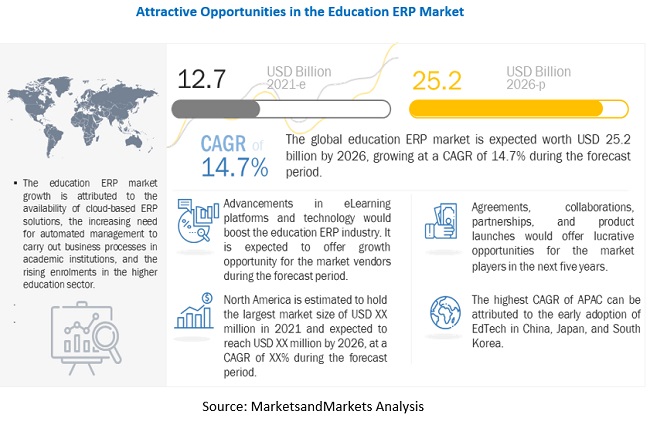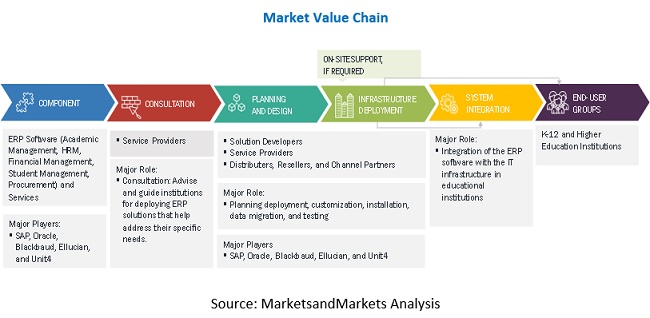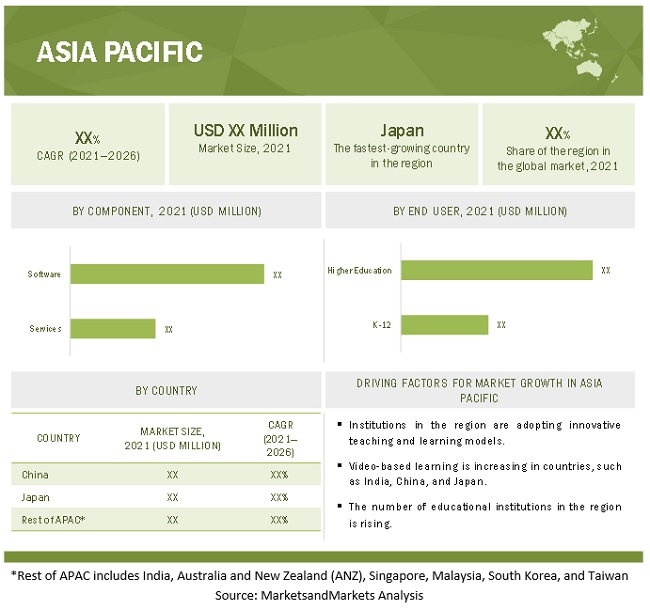< Key Hightlight >
[211 Pages Report] The global education ERP market size is projected to grow from USD 12.7 billion in 2021 to USD 25.2 billion by 2026, at a Compound Annual Growth Rate (CAGR) of 14.7% during the forecast period. The education ERP market is gaining traction due to availability of cloud-based ERP solutions, need of automated management to carry out business processes in academic institutions, enhanced performance of administrative modules increasing the need for managing academic processes, and rising enrollments in the higher education sector.

To know about the assumptions considered for the study, Request for Free Sample Report
COVID-19 impact on the education ERP market
The outbreak of COVID-19 has adversely affected the economy of North America. In the last five months, several industries in this region have been affected due to the pandemic. The closure of educational institutions has impacted students, teachers, and staff and brought societal and economic consequences. Higher education and their students will suffer the most from these unfortunate events as their major career decisions depend upon the higher education classes. In the coming years, automated institute management systems such as student information system and learning management system will be necessary tools for institutions to prepare themselves for all situations
In Europe, owing to the adoption of remote working and online education by most organizations and institutions, the focus on network security, cloud network types, and business continuity has increased in the last few months. Network traffic in the region has increased by up to 50%, as most of the population is working from home. Network costs have increased due to a higher load on fixed, mobile, and data networks. During the pandemic, academic institutes reduced their spending on the development of new infrastructure and services. Owning to the nationwide lockdowns, all academic and administrative processes need to be conducted virtually. This, in turn, is leading to the growth of the education ERP market in the region.
The education ERP market in APAC is growing at a significant rate during the COVID-19 pandemic as due to the nationwide lockdowns in countries, institutions are adopting online learning environments more rapidly than ever. For instance, the Indian educational technology company, BYJU’S, witnessed a 150% increase in the number of new students in March when It announced free access to its learning app. It recorded over 13.5 million new students who were using the platform between March and April to learn. Now that social distancing and school closures have become prevalent, hence, online education will become an essential part of the education curriculum. Educational institutions are also expected to adopt digital solutions in the form of ERPs, which facilitate managing staff, exam information, fees accounts, web portals, and library books.
In MEA, some private universities in countries, such as KSA and UAE, are well equipped for online teaching and learning through earlier investments in online platforms. Whereas in countries such as Iraq and Libya, the lack of access to the internet, insufficient bandwidth in many student households, limited digital skills of faculties and students, and limited availability of online course contents were the challenges faced by governments and institutions with regards to conducting online classes. According to the report “The Effect of Covid-19 on Education in Africa and its Implications for the Use of Technology”, jointly published by eLearning Africa and the EdTech Hub, most institutions in the region received no financial support for tools to help them continue teaching during the crisis and felt that they had insufficient preparation to adapt to the demands of distance learning. However, educators in the region are optimistic about the opportunities that COVID-19 has bought for bringing innovation to education.
In Latin America and the Caribbean, more than 154 million children, or approximately 95% of the enrolled students are temporarily out of school due to the pandemic. Covid-19 has affected the education sector adversely in Latin America. However, these industries are trying to adopt online learning tools and ERP software to overcome the challenges faced due to the pandemic.

To know about the assumptions considered for the study, download the pdf brochure
Market Dynamics
Driver: Availability of cloud-based ERP solutions
The adoption of ERP solutions by various academic institutions has improved their operational effectiveness, thereby providing a competitive advantage to organizations. Presently, cloud-based ERP solutions are replacing traditional data management techniques and processes. A cloud-based ERP solution provides enhanced data storage capacity, security, and control. It also gives real-time access to administrators and helps in quick and well-informed decision-making. Increasing operational complexity and rapid variations in business models pose challenges to academic institutions. As such, ERP solutions have been implemented in various academic institutions, which, in turn, has reduced the workload on administrators as these solutions help synchronize and manage various business processes effectively. However, the increased cost of implementing ERP solutions and easy accessibility of open-source applications act as major challenges for the adoption of these solutions by various organizations. Hence, the introduction of cloud-based ERP solutions has opened up innovative opportunities for ERP vendors, as these solutions are increasingly flexible and feasible for end users.
Restraints: Easy availability of new administrative systems
ERP solutions are being adopted and implemented in the education sector. There is an increase in demand for ERP solutions that integrate with administrative solutions to offer comprehensive enterprise solutions. This, in turn, has encouraged vendors to offer new solutions that are capable of harnessing the potential storage strength of various business processes. However, school management software, student information systems, and learning management systems are being preferred over ERP solutions, as they are economical, less complex, and are easily available. Hence, administrative systems act as a restraining factor in the growth of the education ERP market.
Opportunity: Emerging potential markets for education ERP in the academic sector
Education ERP solutions have been implemented across academic organizations. The benefits of education ERP solutions are visible for those organizations having implemented various modules of these solutions for carrying out administrative processes, such as student billing and registration. North America and Europe are widely developing and implementing education ERP solutions. In the Middle East and APAC regions, the adoption of education ERP solutions is still in its growth stage and expected to increase in the coming years. The adoption of education ERP solutions has benefited various organizations by managing functions and modules for teachers, students, and parents on a timely basis. Organizations in North America and Europe are well-equipped with the latest technologies related to the education ERP market. This is due to the increasing inclination of organizations toward the adoption of automated systems. Technologies are being innovated constantly to make business processes increasingly appealing for educators. Emerging markets in APAC, such as Australia, Japan, and China, are readily adopting ERP solutions, which have resulted in the growing demand for various administrative systems, such as Constituency Relationship Management (CRM) and school management software. Local software and product vendors are focusing on this market to offer ERP solutions to new entrants.
Challenge: Lack of technology readiness among faculties
As technology has become an inseparable part of today’s education system, the success of the technology is highly dependent on the tech-savviness of the faculty or instructors. The adoption of techniques, such as course design, assignment development, assessment and evaluation, online content delivery and collaboration, pose challenges to a majority of instructors that have adopted traditional methods to deliver lectures. The factor is not limited to any particular country or region and is a challenge that is faced by educational institutes and faculties worldwide. According to the Educase Horizon report 2019, technological adoption was one of the major challenges faced by educational institutions.
Service segment to account to grow at the highest CAGR during the forecast period
Service segment accounts for largest market share during the forecast period. The services segment is growing due to the increase in the adoption of technological solutions and modules in educational institutions. Hence, service providers are focused on providing dedicated services by understanding the need of educational institutions. The services offer end-to-end functionalities enabling the institutions to implement and manage the ERP system on a timely basis.
Higher Education segment is expected to hold a larger market share during the forecast period
Higher education segment is expected to hold a larger market share during the forecast period. The nature of teaching and learning is changing in the higher education sector. Technology-enabled learning has become more prevalent. The expectations of students from colleges and universities are also evolving. They emphasize easy availability of information, such as online lectures, timetables, and schedules, and faster access to institutional services. Hence, higher education institutions are leveraging technological advancements by adopting ERP software to enhance student engagement and increase student success. Higher education institutions are also adopting digitalized administration systems, thereby paving the way for the implementation of ERP software.
Student Management segment is expected to hold a larger market share during the forecast period
Student Management is expected to hold a larger market share during the forecast period. The education ERP software helps in managing all aspects of student management such as admission procedures, attendance management, maintenance of student records, and tracking student performance and progress, thereby increasing the productivity of educational institutions. Educational institutions are emphasizing increasing enrollments and improving student success rates. Moreover, the education ERP software helps academic institutions to manage their student lifecycle, such as student billing, registration, and enrolments, effectively. Academic institutions are increasingly deploying education ERP software to fulfill the improved management of student information to ensure proper retrieval of information across different departments.
APAC to grow at the highest CAGR during the forecast period
APAC is expected to grow at the highest CAGR during the forecast period. APAC is one of the fastest-developing regions in the world and has the largest student population, making the region highly profitable for the education ERP market. The region is expected to be the fastest-growing market in the global education ERP software market due to the expansion of the customer base for the education ERP software users and the emerging trend of education ERP hybrid development. Educational institutions in APAC are focusing on the implementation of digital solutions and the encouragement of the use of ERPs to seamlessly integrate key processes of an education institute, which include academic, financial, administrative and infrastructure, and communication. The rising significance of video-based learning in various economies, such as India, China, and Japan, will also contribute to drive the market in the region.

The education ERP market is dominated by a few globally established players such as Ellucian (US), Microsoft (US), Oracle (US), Sage (UK), SAP (Germany), and Workday (US).
Scope of Report
Report Metric | Details |
Market size available for years | 2017-2026 |
Base year considered | 2020 |
Forecast period | 2021-2026 |
Forecast units | Value (USD Million) |
Segments covered | By Component (Software, and Services), By Deployment Type, By End User, By Application, and By Region |
Regions covered | North America, Europe, APAC, MEA, and Latin America |
Companies covered | The major market players include Anubavam (US), Blackbaud (US), Brainvire (US), Edumarshal (India), Ellucian (US), Entab (India), Focus Softnet (UAE), Foradian (India), Infor (US), Jenzabar (US), LIBSYS (India), Lighthouse Info Systems (India), Microsoft (US), Oracle (US), Prolitus (India), Ramco Systems (India), Sage (UK), SAP (Germany), Serosoft (India), Skolaro (India), Sparkrock (US), TCS (India), Tyler Technologies (US), Unit4 (Netherlands), and Workday (US) (Total 25 companies) |
This research report categorizes the education ERP market to forecast revenue and analyze trends in each of the following submarkets:
Based on Components
- Software
- Services
- Consulting
- Implementation
- Support and Maintenance
Based on Deployment Type
Based on End User:
Based on Application:
- Student Management
- Academic Management
- Human Resource Management
- Finance and Accounting Management
- Stores and Procurement Management
- Other Applications
Based on Region:
- North America
- Europe
- APAC
- MEA
- Latin America
Recent Developments:
- In April 2021, Tyler Technologies acquired ReadySub, a cloud-based platform that assists schools with absence tracking, filling substitute teacher assignments, and automating payroll processes. The acquisition of ReadySub helps enhance the company’s school solutions portfolio.
- In February 2021, Ellucian partnered with NEOED, a provider of comprehensive HCM solutions for educational institutions, to enhance its talent management solutions. The solutions automate recruitment and onboarding, employee learning, and performance management through a centralized platform. With the partnership, NEOED also supports Ellucian to cover all aspects of human resources in higher education institutions through HCM solutions.
- In October 2020, Unit4 extended the Unit4 FP&A solution with AI-powered forecasting and planning capabilities. The solution enables intelligent forecast and planning, thereby helping organizations make better decisions quickly and effectively.
- In January 2020, Jenzabar partnered with Softdocs, the education-focused Enterprise Content Management (ECM) provider. With the partnership, a Jenzabar-integrated version of the Softdocs Etrieve platform will be available to all higher education institutions leveraging Jenzabar solutions.
- In May 2019, SAP partnered with Apple to provide cloud-based solutions and mobile services to build applications that students and faculty members of King Abdullah University of Science and Technology (KAUST) could use on their smart devices. The application helps mobilize various activities, ranging from checking offered courses, building their schedule for the semester, checking transcripts, and receiving alerts and push notifications.




